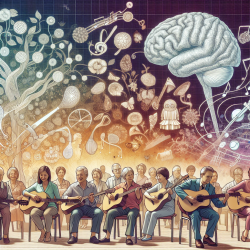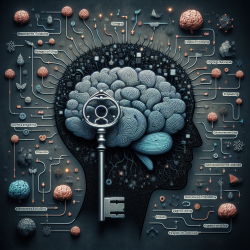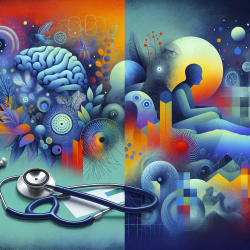Introduction
In the realm of therapeutic interventions, music has long been recognized for its potential benefits in various contexts. Recent research, particularly the study "Exploring Music-Based Rehabilitation for Parkinsonism through Embodied Cognitive Science," offers new insights into how music therapy can be effectively applied to Parkinson’s disease (PD) patients. This blog explores these findings, emphasizing the need for practitioners to incorporate embodied cognitive science principles into their therapeutic practices.
The Embodied Cognitive Science Framework
Embodied cognitive science posits that cognition arises from the dynamic interactions between the brain, body, and environment. This perspective challenges traditional views that consider cognitive processes as isolated within the brain. Instead, it highlights the importance of bodily and environmental interactions in shaping cognitive functions. The '4Es' framework—Embodied, Embedded, Enactive, and Extended cognition—provides a comprehensive understanding of these interactions.
Music Therapy and Parkinson’s Disease
Parkinson’s disease is characterized by motor deficits such as bradykinesia, rigidity, and tremors, which significantly affect patients' quality of life. Traditional treatments often involve pharmacological interventions, but these can be complemented by non-invasive methods like music therapy. The study highlights how music therapy not only improves motor skills but also enhances physiological functions and socio-affective behaviors in PD patients.
Key Findings and Practical Applications
The research underscores several critical points for practitioners:
- Music as a Non-Pharmacological Tool: Music therapy offers a viable alternative or complement to traditional treatments, potentially reducing reliance on medication.
- Improvement in Motor Functions: Rhythmic auditory stimulation has been shown to alleviate gait disturbances in PD patients, enhancing stride length, cadence, and overall mobility.
- Socio-Affective Benefits: Beyond motor improvements, music therapy fosters social interaction and emotional well-being, crucial for holistic patient care.
Encouraging Further Research
While the current study provides valuable insights, it also opens avenues for further exploration. Practitioners are encouraged to delve deeper into the embodied cognitive science framework to refine therapeutic protocols. Understanding the complex interplay between music, cognition, and motor functions can lead to more personalized and effective interventions.
Conclusion
Integrating music therapy into the treatment of Parkinson’s disease offers promising outcomes, aligning with the embodied cognition framework. Practitioners should consider these findings to enhance therapeutic practices, ultimately improving patient outcomes. For a comprehensive understanding of the research, practitioners can access the original study Exploring Music-Based Rehabilitation for Parkinsonism through Embodied Cognitive Science.










